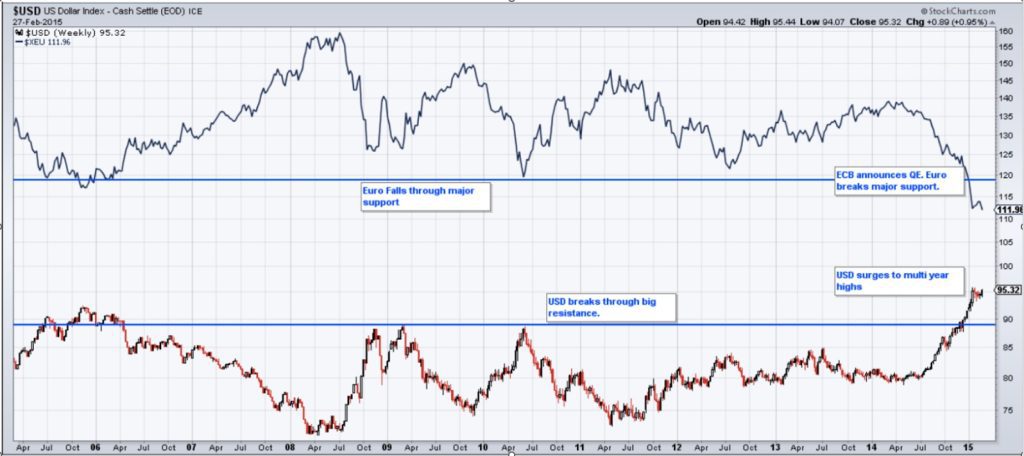The European Central Bank’s (ECB) announced they were launching an investigation phase of the Digital Euro project in 2021. In the wake of this, five companies—including Amazon—are currently in a drafting process to help design a retail payment interface for e-money. Where does crypto come in for the ECB?
The ECB received broad interest in its call for expressions of interest from a pool of 54 front-end provider companies. These are companies who are willing to participate in the prototyping exercise. According to the ECB, the Digital Euro can “contribute to the economic growth” of the Euro Area.
However, the increasing pressure of the US dollar on the euro and growing interest in crypto payments despite the crypto winter paint a different picture for the future of the digital euro.
Here is a look at some of the main hurdles the ECB will need to address head-on. These will need to be addressed before the digital euro takes root.
The Euro Is Weakening
2022 will probably go down as “the worst year in the euro’s history.” However, the euro’s collapse has been well-telegraphed for several years now.
The European Central Bank’s (ECB) quantitative easing program (QE) has been one of the primary drivers of the euro’s decline. The QE was implemented in 2015 to boost the Eurozone economy
Under the 2015 QE, the ECB bought government bonds and other securities in the open market. This purchase was to increase the money supply of the euro and lower interest rates. Unfortunately, this policy has been incredibly detrimental to the euro. It has increased the supply of euros while simultaneously decreasing demand for the currency.
In addition to QE, the Eurozone has implemented several other policies over the years. These other policies have added to the euro’s woes.
First is the European Union’s (EU) bail-in policy introduced in 2014. This policy allows for the confiscation of deposits to rescue failing banks. This led to a decrease in trust in the banking system, as people were afraid that their money could be confiscated anytime.
Second is the negative interest rate policy (NIRP), which was first implemented in 2014. Under NIRP, commercial banks are charged a 0.4% fee on deposits held at the ECB. This has led to a decrease in lending and investment, as banks are reluctant to lend money out when they have to pay a fee to hold onto deposits.
Third, there is the EU’s fiscal compact, which was introduced in 2012. This policy requires member states to maintain a balanced budget and limits government spending.
The Strengthening of US Dollar
Meanwhile, the US dollar has strengthened against the euro over the course of several years.


This trend is set to continue in the coming years as the US economy continues to recover, given the move by the US Federal Reserve to hike interest rates to a 40-year high.
The Rise of Cryptocurrencies
The conflict between Ukraine and Russia has also exacerbated the lack of consumer confidence in the Eurozone and highlighted the need for crypto.
Indeed, a raft of crypto-based benefits, such as the capacity to use crypto to support humanitarian endeavors, has been seen. Simply put, crypto allows individuals to donate directly to those in need without going through conventional centralized methods.
As demand for the euro continues to wane, the popularity of their proposed digital euro remains in question as interest in cryptocurrencies continues to rise despite the crypto winter. Our own internal statistics support this: despite the crypto winter, Q3 2022 figures show 2X the volume of transactions and 1.94X the number of transactions of the same period in 2021.
A Rigid Crypto Demographic
In addition, crypto users are known to be rigid in their decisions about their payment methods. As a result, most crypto natives are accustomed to using USDT, despite the recent controversy around the stablecoin. This is because crypto users are highly skeptical of government-backed fiat currencies and prefer to stick with decentralized cryptocurrencies that they believe cannot be easily manipulated by central authorities.
For this reason, the digital euro must compete with other fiat currencies, such as the US dollar, and emerging crypto-payment solutions.
Suppose the digital euro can’t get traction from crypto-natives, who are essentially the early adopters of any new technology. In that case, it’s hard to see how the digital euro will ever go mainstream.
The Future of the Digital Euro, Crypto and the ECB
So far, the digital euro has been met with much skepticism from the ECB and the crypto community. This is because the digital euro doesn’t offer anything new or innovative that would make it appealing to crypto natives.
What’s more, the digital euro is being introduced at a time when trust in the traditional banking system is at an all-time low and when alternatives to fiat currencies are on the rise.
As such, the best move for the ECB is to focus on integrating crypto’s decentralization into their existing payment infrastructure rather than trying to create a new centralized digital currency from scratch










